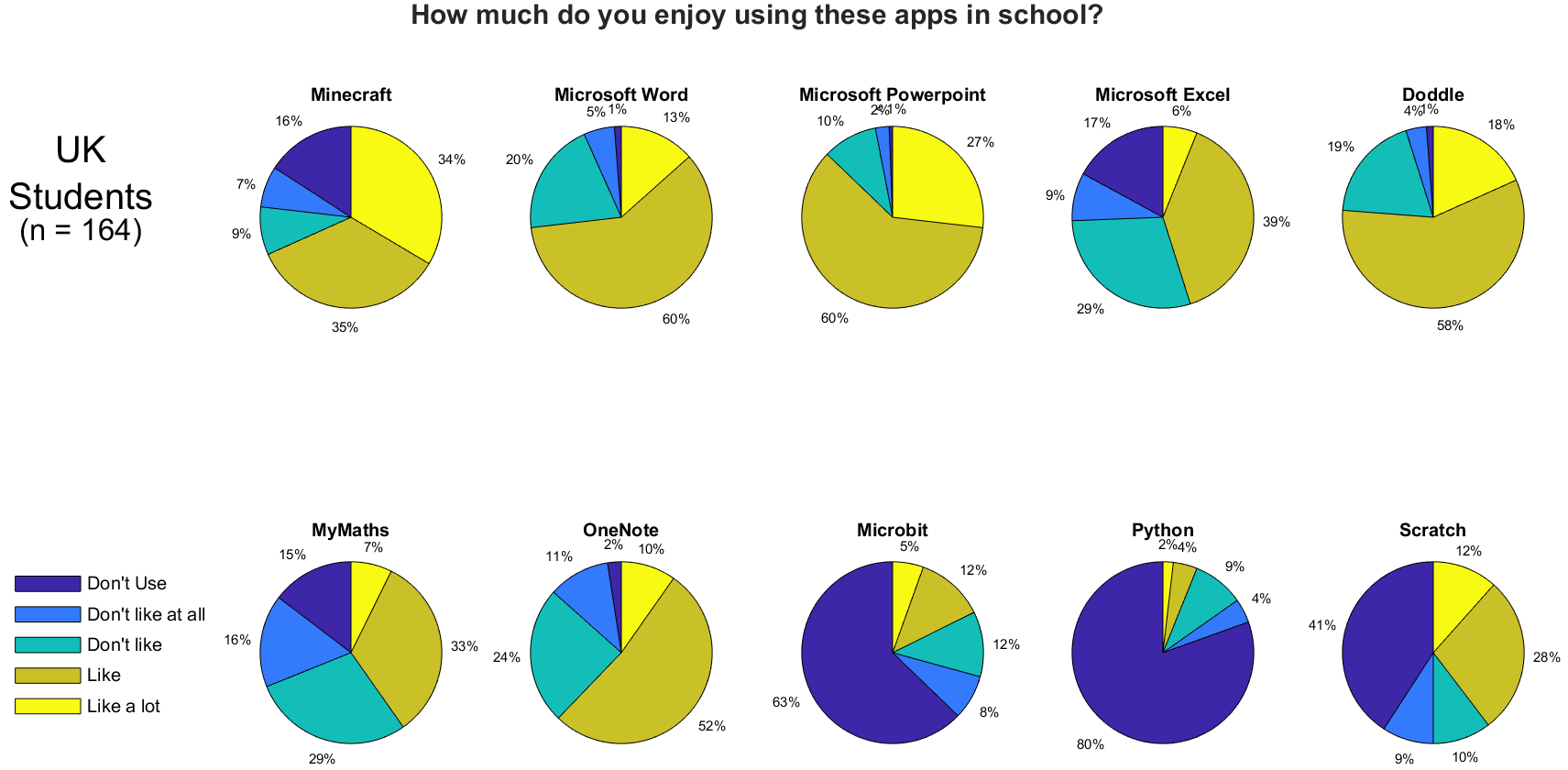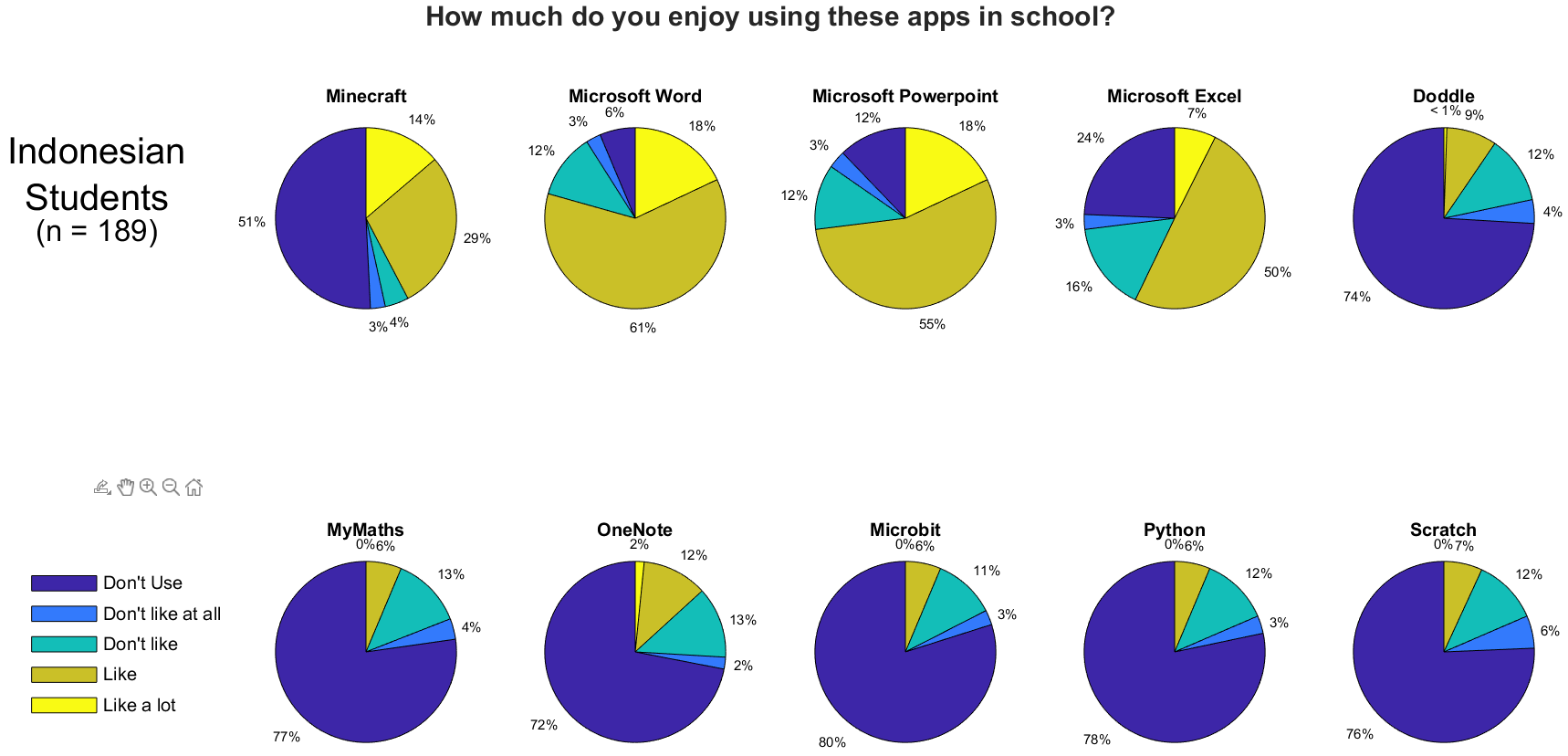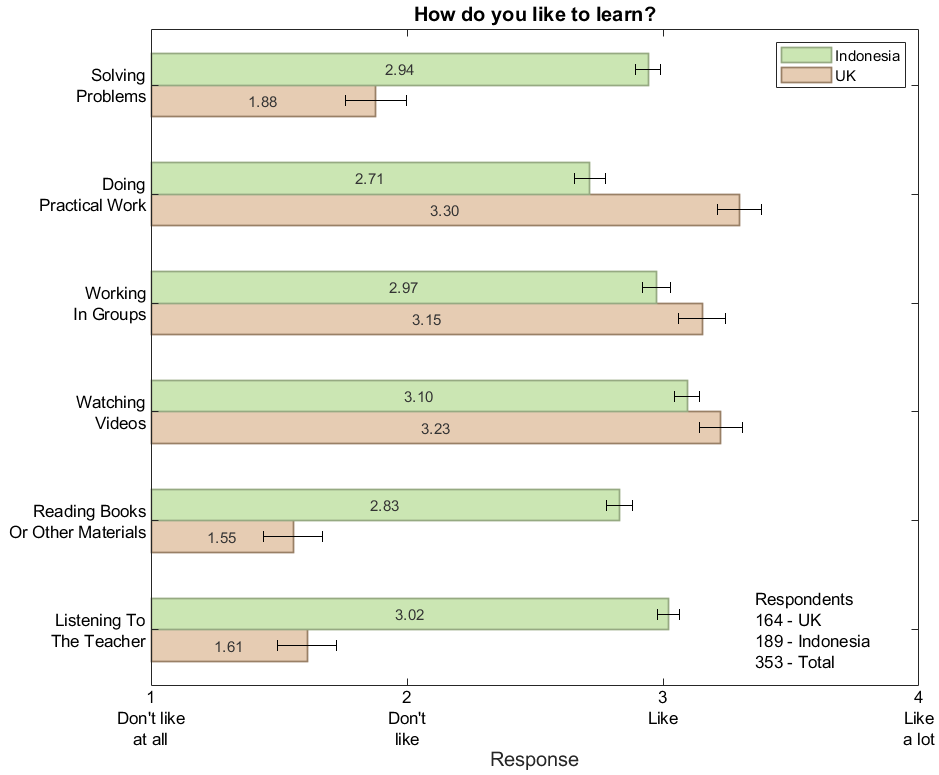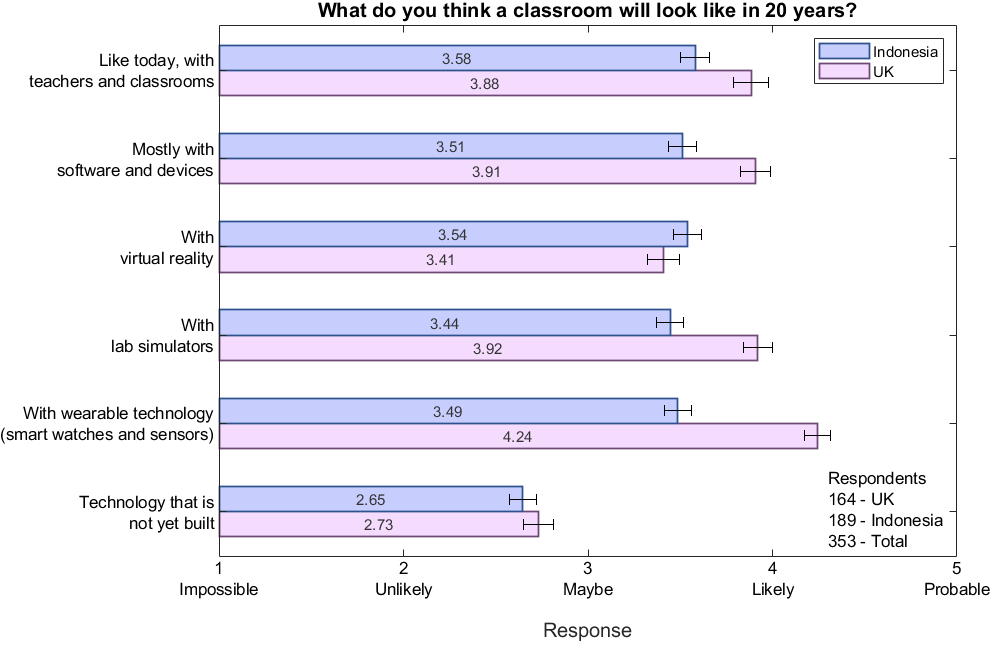Read, J. C., Sari, E., MacKenzie, I. S., & Tedjasaputra, J. (2021). Words, worlds, and freedom: Insights from school students in Indonesia and UK. Proceedings of the 18th IFIP TC 13 International Conference on Human-Computer Interaction - INTERACT 2021 (LNCS 12935), pp. 361-370. New York: Springer. doi: 10.1007/978-3-030-85610-6_21. [PDF]
ABSTRACT Words, Worlds and Freedom - Insights from School Students in Indonesia and UK
Janet C Read1, Eunice Sari2, I Scott MacKenzie3, and Josh (Adi) Tedjasaputra4
1University of Central Lancashire, Preston, UK
2UX Indonesia, Indonesia and Charles Darwin University, Australia
3York University, Toronto, Canada
4Customer Experience Insight (CX Insight), Australiajcread@uclan.ac.uk, eunice@uxindo.com, mack@cse.yorku.ca, josh@cxinsight.com.au
As part of a larger project looking at the design of future classrooms, we delivered a survey on technology use to school pupils in the United Kingdom and in Indonesia. Whilst seeking to discover opinions from the pupils in both of these locations, we also had an interest in exploring what the results might also tell us in regard to future design sessions. Over 300 pupils completed the survey, and the results show significant differences and similarities across the two groups. It can be postulated that some of the differences are caused by the students' behaviours around satisficing, and some are a result of experiences. We reflect on implications for the design of design sessions around words, worlds and freedom.Keywords: Cross Culture, Future Schools, Children, Learning Technologies
1 Introduction
Ever since Seymour Papert, [1], imagined the classroom of the future, there has been an ongoing debate as to how technology affects both the landscape of, but also the philosophy of, education. In the same way that a building affects its people [2], so the products placed in a school affect the dynamics and the learning [3]. As a result of the COVID-19 pandemic, there is an increased interest in the impacts of, and the possibilities for, digital technologies in classrooms. Many papers are considering the impacts of online education on children's learning and wellbeing whilst seeking to imagine future scenarios where technologies become more ubiquitous in schools and, as a result, where these technologies change learning [4, 5, 6].In our broader work, we are interested in the design of technologies not yet imagined and in empowering children to think about design and imagine their futures. This is part of a large ongoing project in which we have previously engaged in design work with children in Malaysia, Iceland and UAE. This earlier work has surfaced to us some problems in such cross-cultural design as we have realized that what might work in one place may not be easily replicable to another. We have noticed that some words need explanation, that we have gaps in our knowledge about children's contexts and we are somewhat ill-equipped to understand the cultural and situational influences on design work. A challenge for us is to articulate these differences and find a framework to help us run better cross-cultural design activities.
It is challenging and expensive in both money and time to explore differences in face-to-face design sessions. For that reason, we were interested to see if we could use a survey method to help us towards a framework for thinking. The work we present here thus explores what can be learned from a survey with children that can help us better situate design with children in an HCI context. We surveyed school-aged children in two quite different countries (Indonesia and the United Kingdom) to answer the following two research questions:
- RQ1: What can be usefully discovered about school with a one size survey for children when applied in quite different contexts?
- RQ2: What can be discovered in a one size survey that can assist in the customization of design activities across different cultures?
2 Related Work
2.1 Education in Indonesia and the UK, and Technologies in Schools
Education in Indonesia emphasizes knowledge over practice and offers a diverse curriculum of subjects that are quite dense and compulsory for students to participate in, ranging from Indonesian (language), civic education, mathematics, religious education, science, social studies, cultural arts, sports, information technology, and communication (ICT). The curriculum is based on, and has a large emphasis on, the five values of Pancasila as described in [7]. Sadly the education system as a whole is considered one of the worst in the world and it is beset with many challenges [8]. In the UK, despite some recent politically motivated efforts, little in education is about national values [9]; the emphasis is on practice and skill development. The standard curriculum includes languages, mathematics, social studies, and science but also extracurricular development in the fields of technology, arts, and sports. The nations of the UK (England, Wales, Scotland and Northern Ireland) each manage their own education provision and each have their own national curriculum, e.g., [10], but the general values are the same with an emphasis on specialization and with externally managed qualifications that have credibility and currency across the world.
UK schools are all imbued with technology. Microsoft has a Microsoft Schools programme1 within the UK where schools become flagship centres of computer supported learning. Many schools across the world have taken on a BYOD (Bring your own device) approach to learning where pupils bring devices to school. There have been studies of similar approaches in Indonesia for example Supardi, [11], who studied the attitudes of junior high school students, 11-13 years old, living in Yogyakarta and experiencing HTBL (High Technology Based Learning) at school. The results of this research applauded the fun and accessibility of that approach to learning. It is highly likely that in the future all children will have devices in school and that classrooms will be significantly affected by technology.
Software for schools is a huge business. Much of the software used in schools is there to facilitate general learning. Microsoft products are widely used for this purpose across all schools with PowerPoint and Word being extremely commonplace [12, 13, 14]. Whilst now being ubiquitous, it has not always been the case that teachers have felt comfortable with these products – as evidenced by a 2007 book on how to use Word in classrooms [15]. The proliferation of Microsoft products into schools is not restricted to the UK – a study in 2018 of education in Iran referred to Microsoft Word as being the most useful educational technology on offer [16] – but there is certainly a lag between the richer and poorer countries. Other Microsoft software like Excel and OneNote is also well used and some products, like Minecraft, have become widely adopted for many uses beyond their immediate remit [17]. Virtual Learning Environments (VLEs) are also very much on the rise in education. Some, like Google Classroom and Doddle are particularly well suited to school use and it is probably fair to say that in most cases the pupil's perception of these will be quite different from the teacher's perception so is valuable to capture.
Software for programming tends to be international in spread, Scratch is an example of a product that is used the world over [18]. Software associated with subjects within curriculums tends to be more localized. One example is MyMaths,2 which claims to cover the UK curriculum from Key Stage 1 to A Level with interactive lessons, "booster packs" for revision, and assignable homework.
The different shapes and substance of two different educational systems provide a useful backdrop to explore methodological as well as practical solutions to explore education from a pupil's perspective. Of interest in this paper is - can this be effectively done using a survey? What does such a survey show?
2.2 Child Centred Design of Future Education and HCI4D
HCI4D refers to the application of HCI in areas beyond the USA / UK / European paradigms in an effort to better fit solutions to local cultures - especially those where the countries are developing. Abdelnour-Nocera, [19], writes of the need to take into account diverse cultural and contextual positions in order to make good technology. In this endeavour, the voices of children are critical. In the design of education, where in order to de-colonize any discussion, there is a need to explore how to integrate multiple forms of knowledge; connection with diverse cultures is essential [20].
Human Centered Design is an appropriate approach for the design of future education. One approach can be to ask teachers; in a study of teachers views of technology in Indonesia, Mukminin, [21], describes that the positive belief from the teachers, that technology has a lot of potential to improve students' performance, determines the success of technology adoption in classrooms. This is helpful to know but does not really take into account the children's views.
The HCI community has a long tradition of user engagement in design – this is also found in Child-Computer Interaction where there is a significant emphasis on engaging with children in participatory and co-design activities in order to gather their views, [22, 23]. When carrying out these activities, much emphasis has to be placed on designing appropriate activities to scaffold the children towards design [24]; situating the activity in the local context and asking appropriate questions [25]. In meeting this challenge we strongly believe in the sentiments expressed by Fisher [26, 27] that in order to plan and do design with children we should "understand the nature of their activities, to understand common strands as well as the differences, particularly as they are affected by factors pertaining to culture, ethnicity and gender in a rapidly changing world."
Our work therefore in this study seeks to see how much we can discover about contexts with a simple survey. How can this be used in the planning of design activities?
3 Study
Our study used a questionnaire to discover pupils' views on their current education and their thoughts for the future. A questionnaire is an effective tool for gathering a large amount of data from a large group in a cost-effective way [28], and it is an easy method for children and young people to interact with as, and, with appropriate questions, it can be low effort to complete [29]. The downside to a survey is that it typically will not give explanations for the observed results. Our survey in this study was intended to gather data about:
- Factual things - do you know this software – do you like it?
- Opinions based on experience – how do you like to learn?
- Opinions based on imagination – what will the future look like? The survey would be distributed, completed and then considered in regard to its value taking account the two research questions that appear earlier in this paper.
3.1 Survey
The Survey asked pupils to record their age and gender and then to reflect on ten software products that have been reported as having been used in schools in the UK and for each one to record a score between "don't like at all, don't like, like, like a lot". They were then asked about how they liked to learn with a four-point Likert style scale. Finally, they were asked to predict the classroom of the future with a five-point Likert type scale in terms of how likely some scenarios might be in classrooms 20 years from now. The questions and responses are clearly shown in Figures 1, 2, 3 and 4.
3.2 Procedure and Participants
In the UK, the survey was delivered using Microsoft Teams, in Indonesia, it was distributed by the class teachers. The survey was completed by 164 UK (99 male, 65 female) and 189 Indonesian (93 Male and 96 Female) students aged 12 and 13. The UK students were from a single school in England; in Indonesia the students were from 4 schools. All the students participated voluntarily; no incentives were given for participation. No personal data was gathered. Pupils were clear as to the purpose of the survey and told they did not need to submit the survey even after completion.
3.3 Results
Figures 1 and 2 refer to the results from the first question which was about software preferences. Figure 1 shows the results from the UK students.
Fig. 1. Opinions of software by UK students
It is immediately clear (from little dark blue) that the UK students were heavy users of Microsoft Word and Microsoft PowerPoint, as well as Doddle and OneNote. By proportion the most liked product was Minecraft, and the least liked product was MyMaths.
Fig. 2. Opinions of software by Indonesian students.
Figure 2 shows the results from the Indonesian students. It is immediately clear that these students were heavy users of Microsoft Word and Microsoft PowerPoint and used Excel and Minecraft. Word and PowerPoint were equally liked. It is interesting to note that in Figure 2, MyMaths, which is unlikely to be available in Indonesia, had some 'like a lot' scores. On inspection, there were several respondents who chose 'like a lot' for everything on the list. This resonates with research previously by Read [30], that suggests that quite often children will answer very positively for a set of reasons that are not clear but include the desire to please (satisficing).
Fig. 3. How pupils liked to learn
As seen in Figure 3, there were noticeable differences but also similarities, in how the pupils from the two countries liked to learn. Indonesian students seemed much more positive overall but were especially more positive than the UK students in terms of what might be called non-technology-based teaching – viz. reading, listening and thinking. It could be that the UK students felt more empowered to critique these approaches than their Indonesian peers (as alluded to in critiques of culture and openness like [31]) or it could be that the Indonesian pupils did indeed have a very positive opinion of these approaches.
The final question in the survey asked the pupils about how they might imagine school in 20 years' time. In almost all cases, the UK students had a stronger belief in the possible suggestions. They were very convinced of the potential for wearables but interestingly still strongly believed, as did the Indonesian students, that the school classroom would remain recognizable.
Fig. 4. The school of the future
4 Discussion
4.1 The usefulness of applying a single survey across two cultures to understand students' lived experiences and ideas around education
The single survey was initially designed in the UK. It has helped the UK and Indonesian researchers to have a common ground from the beginning to the end of research process. Despite significant differences between two countries, the single survey provides single uniformity of the types of data collected, which gives consistency when analyzing the large-scale data analysis results. The results showed significance differences, in terms of level of awareness, students' perspectives, and technology adoption between UK and Indonesia.
4.2 Implications of the findings for the planning and execution of design studies with school aged students in pan-international studies
Moving from teacher-centred learning to student-centred learning that focuses on problem solving using real practical cases and technology as a platform seems to have become a trend, especially during Covid-19. The use of technology in learning in Indonesia has significantly increased for both teachers and students. As designers, we need to explore different types and levels of learning activities as well as learning tools to develop technology-based classroom design. The survey completed here gave us some facts about what was being seen in the two countries. In a design workshop we could refer to products like Microsoft Word and Minecraft with some confidence that these would be well understood across both countries. The survey therefore helps us get the 'words' right. Figure 4 suggested to us that the possibilities for imagination were likely to be limited by the experiences of the students. One common activity in design sessions is to look for 'novel' ideas. Without understanding the current 'worlds' of children, we cannot easily understand what is novel and as design researchers from rich developed countries we might unfairly dismiss or under value design ideas simply because they are coming from a less technology-rich world view. It appears that a survey like ours can provide some insights into these technology gaps.
From the results in Figure 2, and perhaps indicated in Figure 3 – which seem to indicate considerably high levels of satisficing – we can see that there may be a need to frame design sessions very carefully in order to ensure students have, and feel, the 'freedom' to express themselves. Without describing one education system as more or less liberal than another – from a survey like the one we have used here – we can simply predict some unwanted conformance and nip it in the bud early on in the way we explain a design session.
5 Conclusion
A small survey carried out in two countries has shown similarities and differences in the use of technology and the opinions of school pupils. Looking into these differences has allowed us to think about how we can adapt the way we work directly with students in future research settings, specifically in design, and have helped the research team towards a better understanding of the contexts and cultures of the different countries. As a quick and effective method to provide useful understanding we found the survey to be very valuable.
Whilst the main aim of our work is not to examine the survey as a tool for understanding cultures, we did find out useful things about the students' perceptions and experiences and at the same time we were able to distill insights – these answered our research questions. Future work will further explore technology in school against a lens of children designing future classrooms and will implement the insights from this work into hands on activities with pupils in the two countries.
References
1. Papert, S., The Children's Machine: Rethinking School in the Age of the Computer. 1993, New York, NY: Basic books. https://dl.acm.org/doi/10.5555/139395
2. Ferrari, M., C. Tinazzi, and A. D'Erchia, Imagining the School of the Future, in Buildings for Education. 2020, Springer, Cham. pp. 41-51. https://library.oapen.org/bitstream/handle/20.500.12657/23056/1/1007102.pdf#page=55
3. Courtad, C.A., Making your classroom smart: Universal design for learning and technology, in Smart Education and e-Learning 2019. 2019, Springer. pp. 501-510. https://doi.org/10.1007/978-981-13-8260-4_44
4. Code, J., R. Ralph, and K. Forde, Pandemic designs for the future: perspectives of technology education teachers during COVID-19. Information and Learning Sciences, 2020. https://drive.google.com/file/d/10RArYQc5J_CJWzcWl1AKIMGjvdJksHZ9/view
5. Williamson, B. and R. Eynon, Historical threads, missing links, and future directions in AI in education. 2020, Taylor & Francis. https://doi.org/10.1080/17439884.2020.1798995
6. Wereley, M., Broda, M., Dunlap, S., Ozar, R., Tefs, G., Blinkhorn, J., & Scherson, A., The Day the Robots Arrived: Use of Telepresence to Support Virtual Experiential Learning in Teacher Education. in Society for Information Technology & Teacher Education International Conference. 2021. Association for the Advancement of Computing in Education (AACE). https://www.learntechlib.org/primary/d/219292/
7. Silalahi, R. and U. Yuwono, The Sustainability of Pancasila in Indonesian Education System. Research in Social Sciences and Technology, 2018. 3(2): pp. 58-78. https://www.learntechlib.org/d/187525/
8. Agus, C. Cahyanti, P.A.B., Widodo, B., Yulia, Y., & Rochmiyati, S., Cultural-based education of Tamansiswa as a locomotive of indonesian education system, in Universities as Living Labs for Sustainable Development. 2020, Springer. pp. 471-486. https://doi.org/10.1007/978-3-030-15604-6_29
9. Elton-Chalcraft, S., Lander, V., Revell, L., Warner, D., & Whitworth, L., To promote, or not to promote fundamental British values? Teachers' standards, diversity and teacher education. British Educational Research Journal, 2017. 43(1): pp. 29-48. https://doi.org/10.1002/berj.3253
10. Roberts, N., The school curriculum in England. 2021.
11. Supardi, S. and E. Hasanah, Junior High School Students' Experiences of High Technology Based Learning in Indonesia. International Journal of Learning, Teaching and Educational Research, 2020. 19(5): pp. 153-166. https://doi.org/10.26803/ijlter.19.5.9
12. Carlson, S., The net generation goes to college. The chronicle of higher education, 2005. 52(7): p. A34. https://cfde.emory.edu/_includes/documents/sections/resources/resourcehubarticle/Net_Generation_Carlson.pdf.pdf
13. Parette, H.P., Blum, C., Boeckmann, N.M., & Watts, E.H., Teaching word recognition to young children who are at risk using Microsoft® PowerPoint™ coupled with direct instruction. Early Childhood Education Journal, 2009. 36(5): pp. 393-401. https://doi.org/10.1007/s10643-008-0300-1
14. Reedy, G.B., PowerPoint, interactive whiteboards, and the visual culture of technology in schools. Technology, Pedagogy and Education, 2008. 17(2): pp. 143-162. https://doi.org/10.1080/14759390802098623
15. Hickerson, A., Learn & Use Microsoft Word in Your Classroom. 2007: Shell Education.
16. Soyoof, A., Iranian Teachers' Perception of the Role of Computers in Classroom. www. mjltm. com info@ mjltm. org, 2018: p. 371. http://dx.doi.org/10.26655/mjltm.2018.6.1
17. Bourdeau, S., T. Coulon, and M.-C. Petit, Simulation-Based Training via a "Readymade" Virtual World Platform: Teaching and Learning With Minecraft Education. IT Professional, 2021. 23(2): pp. 33-39. https://doi.org/10.1109/MITP.2021.3062935
18. Zhang, L. and J. Nouri, A systematic review of learning computational thinking through Scratch in K-9. Computers & Education, 2019. 141: p. 103607. https://doi.org/10.1016/j.compedu.2019.103607
19. Abdelnour-Nocera, J. and N. Rangaswamy, Reflecting on the design-culture connection in HCI and HCI4D. Interactions, 2018. 25(5): pp. 8-9. https://doi.org/10.1145/3264381
20. Wong-Villacres, M., A. Alvarado Garcia, and J. Tibau. Reflections from the classroom and beyond: Imagining a decolonized hci education. in Extended Abstracts of the 2020 CHI Conference on Human Factors in Computing Systems. 2020. https://doi.org/10.1145/3334480.3381808
21. Mukminin, A., Habibi, A., Muhaimin, M., Asrial, A., Haryanto, E., Setiono, P., & Sofyan, S., Vocational technical high school teachers' beliefs towards ICT for the 21st century education: Indonesian context. Problems of Education in the 21st Century, 2019. 77(1): p. 22. https://www.ceeol.com/search/article-detail?id=941018
22. Frauenberger, C., M. Foth, and G. Fitzpatrick. On scale, dialectics, and affect: Pathways for proliferating participatory design. in Proceedings of the 15th Participatory Design Conference: Full Papers-Volume 1. 2018. https://doi.org/10.1145/3210586.3210591
23. Fitton, D. and J.C. Read. Primed design activities: Scaffolding young designers during ideation. in Proceedings of the 9th Nordic Conference on Human-Computer Interaction. 2016. ACM. https://doi.org/10.1145/2971485.2971529
24. Iversen, O.S. and C. Brodersen, Building a BRIDGE between children and users: A socio-cultural approach to child-computer interaction. Cognition, Technology & Work, 2008. 10(2): pp. 83-93. https://doi.org/10.1007/s10111-007-0064-1
25. Lamichhane, D.R., J.C. Read, and D. Fitton, Beneath the Himalayas-Exploring Design for Cultural Evenness with Nepalese Children. 2018. https://doi.org/10.14236/ewic/HCI2018.149
26. Fisher, K.E., K. Yefimova, and A.P. Bishop. Adapting design thinking and cultural probes to the experiences of immigrant youth: Uncovering the roles of visual media and music in ICT wayfaring. in Proceedings of the 2016 CHI conference extended abstracts on human factors in computing systems. 2016. https://doi.org/10.1145/2930674.2930701
27. Fisher, K.E., K. Yefimova, and E. Yafi, Future's Butterflies: Co-Designing ICT Wayfaring Technology with Refugee Syrian Youth, in Proceedings of the The 15th International Conference on Interaction Design and Children. 2016, ACM: Manchester, United Kingdom. pp. 25-36. https://doi.org/10.1145/2930674.2930701
28. Maulana, R., M. Helms-Lorenz, and W. van de Grift, Pupils' perceptions of teaching behaviour: Evaluation of an instrument and importance for academic motivation in Indonesian secondary education. International Journal of Educational Research, 2015. 69: pp. 98-112. https://doi.org/10.1016/j.ijer.2014.11.002
29. Choak, C., Asking questions. Research and research methods for youth practitioners, 2013: p. 90. https://doi.org/10.4324/9780203802571
30. Read, J.C., Validating the Fun Toolkit: An instrument for measuring children's opinions of technology. Cognition, Technology & Work, 2008. 10(2): pp. 119-128. https://doi.org/10.1007/s10111-007-0069-9
31. Tan, C., Comparing high-performing education systems: Understanding Singapore, Shanghai, and Hong Kong. 2018: Routledge. https://doi.org/10.4324/9781351238724
-----
Footnotes:
1.
https://news.microsoft.com/en-gb/2020/05/04/three-microsoft-showcase-schools-will-help-teachers-rol
l-ou
t-remote-learning-across-england/



